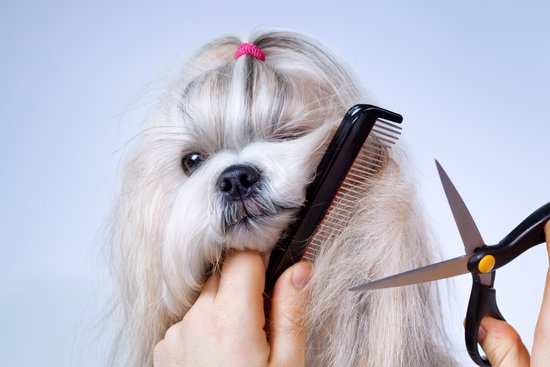Basically, what we want to achieve is, that your dog to feel safe and to feel good while being groomed. In this post, we will discuss in details how to groom your dog at home, without involving any stress.
One important way that we accomplish this is to pair the scary things with good things until the scary things begin to predict good things and we see a change in the dog’s conditioned emotional response (CER). We can identify the change in a dog’s CER by noting the change in his behavior.
Pairing frightening or potentially scary grooming experiences with positive ones is one of the methods we can use in our home and also in our grooming shops. Doing so helps us to reach our goal of helping animals feel safe, thus setting the stage for easier, more relaxed grooming which, in turn, leads to dogs happily returning again and again.
First, we want to recognize that if a dog is too fearful to respond appropriately, it will be difficult to train cooperative care behaviors (such as, for example, stationing and lifting foot and/or remaining still for a nail trim).
The way that we begin in this case is to match one “stimulus” with another scenario to change the function of that stimulus (i.e., pairing). So. for example, if you are able to successfully pair a stimulus (groomer) having the function of “fear” with a stimulus having the function of “happy yum,” you change the function of the scary groomer from “fear” to “happy, yum!!”
Basically what we are saying here is that we want to pair and associate the “groomer” with something the dog likes!
In the past, some harsher methods may have included types of imposing tie-downs and restraints. However, the good news is that today we can accomplish the same grooming goals using gentler methods that do not induce fear or an aversion to grooming.
Moreover, these methods produce long-lasting and positive results that are carried over into all the dog’s future grooming experiences. Rather than forcibly holding or having multiple people hold down a dog, we can teach a dog to comfortably remain in place and to calmly tolerate, if not enjoy, many grooming procedures. This makes the process faster, easier, safer, and more enjoyable for dog, groomer, and human client alike!
While older techniques and options may work in the short term, the issue is that there is a heavy price to pay when using such tactics. The big picture is that we may end up with a dog having great anxiety about the grooming experience in general.
Moreover, the dog has learned, via this one experience, that the grooming shop is a place where it may feel very uncomfortable and frightened. As such, it is very important to understand that shaping a relationship of cooperation between your dog and the groomer (or you, if you do yourself the grooming)—right at the beginning—goes a long way in teaching your dog to generalize the idea of cooperation and trust.
This fostering cooperation is a team effort! Thus, it is very important for the whole team—in this case, the dog, the family, and the groomer—to be on the same page about helping the dog feel comfortable about the grooming process. This is a great opportunity to build a lasting, long-term relationship along with positive grooming behaviors.
Behaviors that may be perceived as uncomfortable should be built slowly and over time. Since grooming is a reoccurring event in the dog’s life, involving many potentially uncomfortable behaviors, building a positive association in this manner
should be an important consideration when going through the process step-by-step.
This way, the guardian is a partner in the process, and the team approach allows for us to more effectively teach the animal to accept and feel comfortable with certain experiences that might otherwise be frightening and uncomfortable.
This is accomplished by creating a strong, positive history of reinforcement that pairs uncomfortable experiences with positive ones as the dog learns to remain still and calm.
If, at any time throughout a process, the dog won’t accept high-value treats, this should provide you with information about the dog’s fear and anxiety level. A dog that is uninterested in high-value treats is indicative of an anorexic dog or a dog whose stress level is over threshold.
If this were to happen, the choice comes down to whether to continue and get the job done as fast as possible, or to stop and take a break. We highly recommend that you take a break and do not “force” the dog to continue. It is scientifically proven that while you might accomplish the groom, forging ahead will only make the fearfulness exponentially worse the next time, which, ultimately, makes for a longer, more dangerous process in the future.
In the case of a matted dog, rather than trying to de-matt a stressed dog, consider the alternative of shaving down the dog, at least the first time. Often, a dog that is highly stressed by going to the groomer’s is most likely matted as a result of not having kept up with regular grooming visits.
Explain to the guardian that your professional recommendation is to shave down the dog for this first time in order to create the least amount of stress while you then start to build a relationship of cooperation. The alternative—de-matting—would only serve to increase the stress, and cause exponentially more anxiety at the next grooming visit.
There are many opportunities for this relationship-building during the grooming process. For many dogs, grooming is often a stressful and anxiety provoking situation. It is our goal to work toward collaboratively helping the dog to feel more relaxed and calm with the grooming shop, its procedures, and the groomer.

